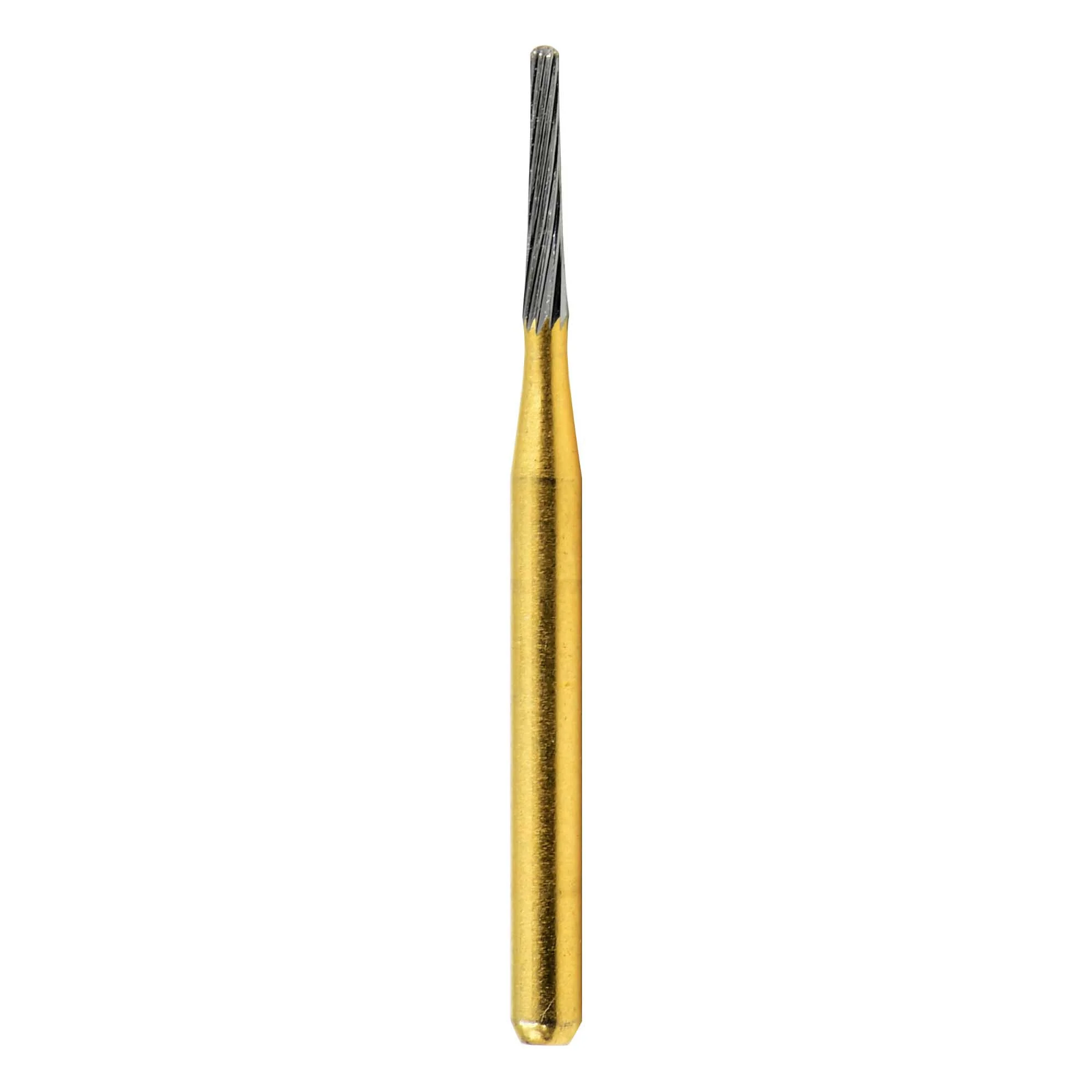The field of dentistry has markedly evolved over the years, with dental burs proving to be fundamental in advancing dental procedures and improving patient care. Selecting the appropriate dental bur for specific tasks is crucial in providing effective treatment and ensuring patient comfort. This article explores the various types of dental burs, their materials, applications, and the innovation surrounding them. By understanding the distinctions among these tools, dental professionals can optimize their practice and enhance patient outcomes.
Introduction to Dental Burs and Their Importance
● Overview of Dental Burs
Dental burs are rotary instruments that play an indispensable role in modern dental practices. Designed for cutting and shaping hard tissues like tooth enamel and bone, they are vital for a wide array of dental procedures, ranging from cavity preparation to restorations. Dental burs come in varied shapes, sizes, and grits, allowing dentists to meet diverse clinical needs efficiently.
● Significance in Dental Care
The importance of dental burs extends beyond their cutting ability. They significantly impact the overall quality of dental care provided, influencing factors such as treatment time, precision, and patient comfort. For a dental practice, understanding the different types of burs and their applications is essential for optimizing patient treatment plans.
Materials Used in Dental Burs
● Diamond Burs: Advantages and Applications
Diamond burs are renowned for their durability and effectiveness in cutting through hard materials like enamel and porcelain. These burs come in varying grades of coarseness, making them versatile for tasks ranging from coarse bulk reduction to fine finishing. Their robust nature ensures longer usability, which can be especially beneficial in high-volume practices or when specific precision is required.
● Carbide Burs: Durability and Precision
Tungsten carbide burs are celebrated for their sharpness and longevity. They are ideal for tasks requiring precision, such as shaping and cutting teeth or removing old fillings. Compared to diamond burs, carbide burs tend to leave a smoother finish. This quality makes them suitable for fine detailing work after the initial cuts have been made.
● Ceramic and Steel Burs: Niche Uses
While diamond and carbide burs are predominant, ceramic and steel burs serve niche purposes in dentistry. Ceramic burs are excellent for gentle, precise dentin removal and are less likely to cause heat buildup, which can affect patient comfort. Steel burs, on the other hand, are often used for tasks that require less precision, like initial cavity preparations, and are valued for their economic advantage in certain practices.
Shank Types and Their Applications
● Long Straight Shanks: Uses in Slow-Speed Procedures
Long straight shank burs are primarily used in slow-speed procedures. These burs are ideal for tasks that require more control and less speed, such as polishing, finishing, or delicate soft tissue work. The design of the shank allows for versatility and adaptability in these slower, more controlled applications.
● Locking Type Shanks: Enhanced Stability
Locking type shanks provide enhanced stability and are commonly used with low-speed handpieces. The locking mechanism ensures that the bur remains securely attached during procedures, reducing the risk of slippage and enhancing precision. This type of shank is particularly useful in procedures where stability and control are paramount.
● High-Speed Shanks: Optimizing Efficiency
Friction grip (FG) shanks are designed for high-speed dental handpieces, optimizing efficiency in procedures that require rapid material removal or cutting. These shanks are small and compact, allowing for quick changes and precise manipulation. They are preferred in procedures where quick and aggressive cutting or preparation is required.
Understanding Burs by Shape
● Barrel and Cylindrical Burs: Common Uses
Barrel and cylindrical shaped burs are commonly used in dentistry for smoothing and finishing. Their straight edges make them perfect for reducing tooth height, leveling surfaces, and creating flat surfaces within the cavity preparation. These burs are versatile tools in a dental practitioner’s arsenal, providing solutions for a variety of tasks.
● Soccer Ball and Egg-Shaped Burs: Specialized Functions
Soccer ball and egg-shaped burs are specialized for sculpting and creating smooth contours. They are particularly useful in restorative procedures where rounded edges and smooth transitions are necessary. These burs help in managing surfaces that require gentle curves and are less likely to cause rough edges that might compromise the restoration.
● Flame and Feather Burs: Intricate Procedures
Flame and feather burs are tailored for intricate procedures, providing fine tapering and finishing capabilities. Their pointed tips and fine edges are particularly adept at accessing and refining hard-to-reach areas, making them ideal for fine detailing in aesthetic restorative work. They are a go-to choice when precision and delicate handling are required.
Selecting the Right Bur for Different Procedures
● Factors Influencing Bur Selection
When selecting a dental bur, several factors must be considered, including the material's hardness and the type of procedure. The abrasiveness, shape, and size of the bur should align with the specific needs of the procedure to ensure optimal results. Additionally, the choice between single-use and reusable burs can impact cost and hygiene practices.
● Matching Bur Types to Procedure Needs
Each dental procedure has its unique requirements, and selecting the right bur can significantly improve outcomes. For example, round burs are often used for initial cavity preparation, while tapered fissure burs are more appropriate for creating precise cavity walls. Pear-shaped burs might be chosen for undercutting, and finishing burs are ideal for polishing and contouring.
● Examples of Procedure-Specific Burs
Certain burs are specifically designed for particular procedures. Surgical burs, for instance, are often made of tungsten carbide or diamond for enhanced cutting ability in oral surgery. Finishing burs, on the other hand, are used to smooth and polish restorations, ensuring a natural look and feel.
Diamond vs. Carbide Burs: A Comparative Analysis
● Strengths and Weaknesses of Each Type
Diamond burs excel in cutting through hard materials and providing a rough finish that aids in material adhesion. However, they may generate more heat and require caution to avoid damage to surrounding tissues. Carbide burs offer smoother finishes and less heat production, making them suitable for fine finishing work. Yet, they might not be as effective in cutting through ultra-hard materials as their diamond counterparts.
● Situational Appropriateness
The choice between diamond and carbide burs often depends on the specific requirements of the procedure. In situations where aggressive cutting is necessary, such as initial cavity preparation or crown removal, diamond burs may be more effective. Conversely, for procedures requiring precision and fine detailing, carbide burs are generally preferred.
● Cost and Longevity Considerations
Cost-effectiveness is also a consideration when choosing between diamond and carbide burs. While diamond burs tend to be more expensive, their durability can justify the cost over time, especially in high-volume settings. Carbide burs, while also durable, may require more frequent replacement depending on the level of use and the types of materials encountered.
Innovations in Dental Bur Technology
● Recent Advancements in Materials and Design
Advancements in dental bur technology have led to more efficient and effective tools. New materials and design innovations have enhanced cutting precision, durability, and user comfort. Innovations such as multi-layer diamond coatings and enhanced carbide compositions have improved both the longevity and performance of dental burs.
● Impact of Technology on Precision and Care
Technological advancements have a significant impact on the precision and quality of dental care. The development of more refined burs enables dentists to perform intricate procedures with greater accuracy, reducing treatment time and enhancing patient outcomes. Moreover, these improvements contribute to patient comfort by minimizing discomfort associated with dental procedures.
● Future Trends in Dental Burs
The future of dental burs is likely to see further enhancements in materials and designs, focusing on increasing the efficiency and effectiveness of dental procedures. Developments in digital dentistry and 3D printing may also play a role in the evolution of dental burs, offering new possibilities for customization and precision in tooling.
Maintaining and Caring for Dental Burs
● Proper Cleaning and Sterilization Techniques
Proper cleaning and sterilization are vital in maintaining the effectiveness and longevity of dental burs. After each use, burs should be thoroughly cleaned to remove debris and contaminants before being sterilized using appropriate methods, such as autoclaving. This practice prevents infection transmission and ensures burs perform optimally.
● Storage Solutions to Prolong Life
Storing dental burs properly helps prolong their lifespan and maintain their cutting efficiency. Burs should be stored in protective cases or racks that prevent damage to the cutting edges. They should also be kept in clean, dry environments to prevent corrosion and degradation.
● Indicators of Bur Wear and Replacement Timing
Recognizing when a bur is worn and needs replacement is critical for maintaining performance standards. Indicators of wear include reduced cutting efficiency, the presence of corrosion, or visible damage to the cutting surface. Regular inspections can ensure that burs are replaced promptly to maintain procedure quality.
Impact of Dental Bur Selection on Patient Care
● Correlation Between Bur Choice and Treatment Quality
The selection of appropriate dental burs directly correlates with the quality of treatment delivered. Using the right bur can reduce treatment time, enhance precision, and improve the overall patient experience. It allows for more efficient procedures, minimizing discomfort and achieving more predictable outcomes.
● Reduction of Patient Discomfort Through Appropriate Selection
Careful selection of dental burs can significantly reduce patient discomfort during procedures. For instance, using burs that cut efficiently with minimal vibration and heat generation helps in maintaining patient comfort and satisfaction. This is especially important in long or complex procedures.
● Enhancing Procedural Efficiency
Selecting the right bur not only enhances treatment quality but also increases procedural efficiency. Efficient burs cut faster and cleaner, reducing chair time and allowing practitioners to treat more patients effectively. This efficiency translates into better practice management and improved patient throughput.
Conclusion: Mastering Dental Burs for Optimal Outcomes
● Recap of Key Points on Burs and Applications
Dental burs are essential tools in dentistry, offering a range of shapes, materials, and designs to cater to various dental procedures. Understanding the nuances of each type, including material differences and application-specific designs, is crucial for optimizing patient care and treatment effectiveness.
● Importance of Continuous Learning and Adaptation
Continuous learning and adaptation to new innovations and technologies in dental burs are vital for dental practitioners. Staying informed about the latest developments ensures that dentists can provide the highest level of care, utilizing tools that improve efficiency and patient outcomes.
● Encouragement for Practitioners to Stay Informed
Dental professionals should remain proactive in learning about new bur technologies and techniques. Engaging in continued education and practical workshops can empower practitioners to leverage the full potential of these tools, thereby enhancing their practice and contributing to better patient care.
About Boyue
Jiaxing Boyue Medical Equipment Co., Ltd is a leading manufacturer renowned for mastering 5-axis CNC precision grinding technology. Specializing in medical rotary cutting tools, Boyue offers a comprehensive range of products, including dental burs, dental files, bone drills, and tools for orthopedic and neurosurgery operations. Their advanced R&D team, rigorous inspection processes, and large production capacity ensure superior product quality. With over 23 years of experience, Boyue stands out as a premier supplier of carbide burrs and dental files, providing exceptional prices and service in the global market.

Post time: 2025-01-10 16:18:06


